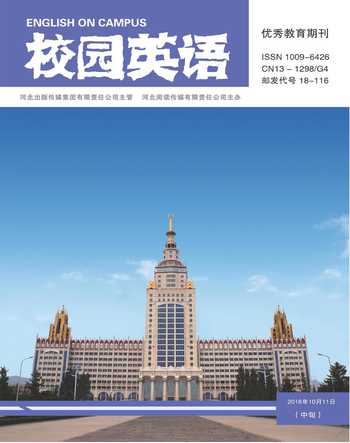A Study of Content Validity of Reading Comprehension in CET—4
2016-05-30徐腊梅
徐腊梅
【Abstract】This paper analyzes the content validity of reading comprehension in CET-4 in December, 2013 (the first test after some changes to this exam) . The results show that the design of reading comprehension conforms to the standards of CET-4 Testing Syllabus but needs further improvement. The paper proposed several pieces of advice based on the results.
【Key words】Text Input; Expected Response; Content Validity
1. Introduction
CET-4, playing a crucial role in testing Chinese students English language ability, is one of the most influential tests in China. After a long period of preparing, the new CET-4 came to peoples sight in December, 2013. To figure out the future direction for collage English curriculum reform and improve the quality of collage English teaching, it is necessary to deliberate on content validity.
2. Background
In Longman Dictionary of Language Teaching and Applied Linguistics, content validity is“a form of validity which is based in the degree to which a test adequately and sufficiently measures the particular skills or behavior it sets out to measure.” In a test, content validity can be identified from three aspects: 1) whether the content of the test is relevant to its goal; 2) whether the content is representative; 3) whether the content can represent its subject (Liu, 2000: 208).
In this paper, I randomly select one out of those test papers and analyze it based onBachman and Palmers Test Task Characteristics Model, in which 5 major factors—test environment, test instruction, text input, expected answer and the relations between text input and expected answer—are mentioned. This paper will mainly focus on text input and expected answer.
3. Results and analyses
3.1 Text input
The analyses of text input (Graph 1) will include four parts –text length, readability, text type and subject matter. Text type includes exposition, narration and argumentation.Meanwhile, subject matter involves social sciences, humanities and natural sciences.Readability is analyzed in Microsoft Office Word 2007 through inspection of spelling and grammar and evaluated based on Flesch Reading Ease (Rudolf Flesch).
As for text length, the Syllabus stipulates that the total number of vocabulary in fast reading is around 1000 words; gap filling in careful reading around 200-250 words; multiple choice in careful reading around 300-350 words. According to Graph 1, gap filling and fast readingmeet the requirement of the Syllabus, while multiple choice 1 and multiple choice 2 slightly outstrips the length required by the Syllabus.

As with readability, the Syllabus stipulates that the scale of careful reading should be standard, fast reading fairly easy and length reading not too difficult. From Graph 1 and graph 2, fast reading (61.7) adequately meets the requirement of the Syllabus. Meanwhile, the readability of three careful readings (48.1, 45.2 and 52.6 respectively) stands between fairly difficult and difficult. In all, readability is moderate, showing the scientificity and preciseness of the test programming group. However, the two careful reading are slightly difficult. Reading two equally difficult academic texts is not easy for average college students. Thus, some improvements still need to be made in terms of controlling the readability of the text.
the Syllabus requires diversities from types and subject matter.In this test, gap filling, multiple choice 1and multiple choice 2 belong to social exposition; fast reading is a social argumentation. Based on above analysis, this test is featured by unitary subject matter because all the four texts are about social sciences and meanwhile text types are not diverse enough because 3 out 4 are expositions. Therefore, contents of this test did not appropriately meet this requirement.
3.2 Expected answer
Reading comprehension in CET-4 is devised mainly to test students ability to acquire written information through reading, including the main idea, important truth and details, implied meanings, writers perspective and attitudes etc. The abilities tested in CET-4 in December, 2013 are listed in Graph 4, which shows there are 20 problems to be solved all together and most of them focus on discerning and understanding the main ideas as well as important details. Besides, only one of them tests students ability to make use of language skills, and none of them test special reading skills. Therefore, one proposal from above discussion is that test-makers should pay more attention to the balance between skills tested.
4. Conclusion
Reading comprehension in this test shows some degree of validity, though not completely.So in general, it meets the requirement of the Syllabus. Specifically, text length, readability,text type, subject matter and skills tested fundamentally meet the standards. However, there are still some problems needed to be pointed out. First, the types and subject matter are unitary, concentrating on expositions, especially social scientific ones. Second, the difficulty level of texts fluctuates sharply. Third, skills tested in this exam are unbalanced.
Based on above analyses, it is suggested that reading comprehension should attach more importance to the diversities of text type and subject matter. Besides, the difficulty level should be more stable (in the range of 50-70). Last but not least, abilities tested should be in a balance. Problems testing students language skills and reading skills should make up a larger part so that reading comprehension can test students reading abilities in a more comprehensive way.
References:
[1]Bachman & Palmer.Language Testing in Practice[M].Oxford University Press,1996: 49.
[2]Richards J.& R.Schmidt.Etc.London Dictionary of Language Teaching and Applied Linguistics[M].Foreign Language Teaching and Research Press,2009: 148.
[3]Department of Higher Education.College English Curriculum Requirements(for trial implementation)[M].Beijing: Higher Education Press,2004.
[4]CET Committee.Syllabus for College English Test—Band Four(CET-4)[M].Shanghai Foreign Language Education Press,2006.
[5]Liu Runqing,Han Baocheng.Languge Testing and Its Methods [M].Beijing:Foreign Language Teaching and Research Press,2000.
